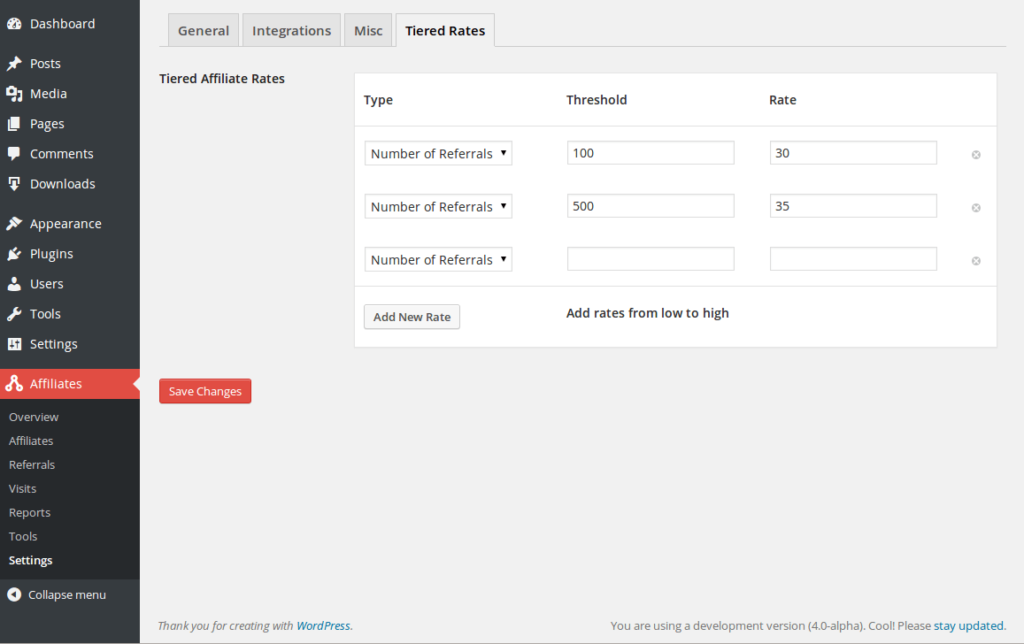In today’s WordPress community there’s no shortage of entrepreneurial developers—many of whom are working on new ideas, new products, or new WordPress related services. And they all have one thing in common: constantly trying to come up with the next big thing!
In 2014, innovation may seem increasingly more difficult. This is due to the fact that many “new” ideas have already been executed, and many needs are already being met. But sometimes taking a fresh look at a seemingly “solved” problem can result in great breakthroughs . . . particularly when you have a vision that provides a better or simplified solution.
You don’t always have to invent something new. Apple wasn’t the first company to make a smartphone, but they did successfully reinvent the idea with the introduction of the iPhone. In the realm of affiliate marketing, AffiliateWP has also reinvented an idea, so to speak.
AffiliateWP and Affiliate Marketing
I first heard about AffiliateWP when Pippin Williamson mentioned it in the Apply Filters podcast. As I understand it, the goal was to come up with an affiliate platform for WordPress that was simple to use, easy to install, and flexible enough to have a good shot at being the new de facto standard in the WordPress community.
 Affiliate Plugins?
Affiliate Plugins?
Broadly speaking, there are two types of affiliate plugins:
1. The first type of plugin helps you earn revenue by referring your readers to external sites.
2. The second type is used to help those who are actually running the eCommerce site and need to pay commission for affiliates to refer visitors.
AffiliateWP plugin falls into the second category.
How Do Affiliate Plugins Work?
If you’re unfamiliar with affiliate systems, here’s a quick summary:
Most affiliate plugins work by giving each affiliate a unique ID that’s used when linking to your site. A cookie is set in the client’s web browser to record the fact that it came from affiliate X. This is tracked as a visit. If a user proceeds to complete a transaction, the visit is marked as a sale. A percent of that sale is then paid to the respective affiliate.
AffiliateWP Has the Basics Covered

Upon activation of the plugin, you’re presented with a menu that provides access to all of the views and settings. If you’ve had prior experience with an affiliate system—of any type—you will immediately understand what’s going on.
Visit the Settings section, and select the integration you need—as long as you’re using a supported eCommerce tool (see below for more on this) this process is very simple.
Also under Settings, you’ll have to select the percentage of commission you want to give affiliates, and then set up the WordPress pages for affiliates to sign up and manage their accounts.
All of this is very straightforward, but further instructions are available from the AffiliateWP website.
Does AffiliateWP Support Your Setup?
This type of plugin isn’t very useful unless you can easily integrate it with popular WordPress eCommerce plugins. The good news is that many popular eCommerce plugins—WooCommerce, Shopp, WP eCommerce, and Easy Digital Downloads—are already integrated with AffiliateWP.
AffiliateWP also looks after the users of some membership plugins with support for Wishlist Member, Paid Membership Pro, and Restrict Content Pro.
There’s also partial support for Gravity Forms—and work is still being done on this integration, but it’s an inclusion I haven’t seen in an affiliate plugin before.
See the full list of integrations here.
Tools for Affiliates
The AffiliateWP plugin allows you to easily create a well-presented page for your affiliate users in order for them to to track their progress.
They can create their own unique affiliate URLs, view the number of referral reports (users of Easy Digital Downloads will be familiar with the presentation of these), and check how much commission they’ve made.
Tools for You
The plugin provides extensive reporting for the site owner. It shows paid and unpaid earnings, visits across the system, and overall usage of individual affiliates.
In the tools section, you have the ability to export sales as a CSV file as well as import/export options for global settings.
For a plugin released just last week, AffiliateWP has an impressive amount of functionality.
Add-ons for AffiliateWP
It has become increasingly more popular for plugins to have a central plugin business model—where the basic plugin is either paid or free, and the objective is to sell a variety of add-ons for the respective plugin.
AffiliateWP is heading down this path with Tiered Affiliate Rates. This add-on is already available, and there are several others coming soon.

This model keeps the central plugin reasonably priced, and allows users to select the extra functionality they desire. It also opens up opportunities for other developers to get involved in the project by submitting add-ons.
Is AffiliateWP for you?
• If you’re looking to start an affiliate program for your WordPress powered site, AffiliateWP is certainly a well-rounded tool for the job.
• If you’re using something else right now, you should access the features and determine if a migration is worth it for you.
• If the future of add-ons offered by AffiliateWP is nearly as robust as the options for Easy Digital Downloads, there will definitely be an increased temptation to migrate your setup to access a broad range of tools and functionality.
Check out the AffiliateWP website here.
Has anyone used AffiliateWP? Let us know what you think in the comments section below!
Peter is co-founder of TheDMA.com.au, an Australian based WordPress development company and HelpForWP.com a WordPress plugin author. You can find Peter Shilling on Twitter @PShilling.




1 Comment